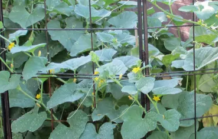Experts encourage planting nectar-producing plants ahead of fall migration.
With the summer season ramping up, experts with Texas A&M AgriLife said now is the ideal time to create an oasis for monarch butterflies that will funnel through Texas during their annual fall migration to Mexico.
Although monarchs are generally known for their specialized relationship with milkweed plants, they rely on a wide variety of nectar-producing plants during fall migration, said Wizzie Brown, Texas A&M AgriLife Extension Service program specialist in the Texas A&M College of Agriculture and Life Sciences Department of Entomology, Travis County.
“They usually start heading south through Texas around September into November,” Brown said. “At that time, our goal is to provide them with enough nectar resources and energy to make it to their overwintering grounds.”
Monarchs and milkweed in the fall
Texas is home to roughly 30 native milkweed varieties, and while these plants do provide nectar, their primary role is as a host plant for monarch eggs and caterpillar development during the spring.
However, tropical milkweed, a popular non-native variety commonly sold in garden centers, blooms longer into fall than native milkweed varieties.
Because of this, Mike Arnold, Ph.D., professor and director of The Gardens at Texas A&M University, suggests pruning back tropical milkweed as fall approaches.
“If you don’t prune it back, some of the butterflies may be tempted to stay because they have a steady source of food,” Arnold said.
Monarchs who remain face the threats of harsh winter temperatures and scarce resources. They are also susceptible to parasites that favor late fall and winter conditions.
“We incorporate native and tropical milkweed plantings in the garden, so we’re able to provide a variety of monarch host plants during the spring, but we prune our tropical milkweed all the way to the ground as we approach fall,” Arnold said.
A smorgasbord of fall nectar options
With a migratory journey of roughly 3,000 miles, it is critical for monarchs to find sustenance along the way. Brown and Arnold said there are a variety of native nectar-producing perennials that provide beautiful landscaping options, thrive in Texas’ oftentimes harsh climate, and, most importantly, benefit monarchs and other pollinator species. These selections include:
- Gregg’s mistflower.
- Frostweed.
- Fall aster.
- Maximilian sunflower.
- Blazing star varieties.
- Goldenrod varieties.
- Flame acanthus.
- Buttonbush.
Arnold said now is the time to plant these fall-blooming perennials so they become relatively established before the stressful heat of summer.
Annual flower varieties provide additional nectar sources as well as color to a pollinator landscape. Although not native to Texas, annuals like zinnias, marigolds and cosmos thrive within the region and provide dynamic colors to the landscape.
If landowners want to plant these flowers specifically for monarchs, Arnold suggests waiting until mid-to-late summer to sow seeds.
“If planted now, these blooms will peak during the heat of the summer prior to migration,” Arnold said. “With a little planning, you can ensure the flowers are in peak bloom during monarch migration.”
In addition to nectar sources, Brown said providing insects with safe access to water is always a good idea.
“I recommend a shallow dish with pebbles or decorative shells that provide a landing surface above the water,” Brown said. “In order to avoid mosquitoes, you want something that will dry out every three to five days, but that also means you will need to refill with clean water.”
Incorporating pollinators into land management goals
Chase Brooke, AgriLife Extension small acreage and wildlife management program specialist with the Department of Rangeland, Wildlife and Fisheries Management, Stephenville, said aiming for plant diversity is a good strategy whether managing a suburban backyard or expansive rangeland.
“Anything we do to add native plant diversity to our landscape and benefit pollinators is always going to be good,” he said.
Brooke said concerted neighborhood-scale conservation efforts, such as incorporating pollinator gardens and native vegetation into residential and municipal properties, are important as the Texas landscape becomes increasingly urbanized and fragmented.
Small Acreage — Big Opportunity is a collaborative effort between AgriLife Extension and the Texas Wildlife Association to empower owners of small parcels — 100 acres or less — to explore options for wildlife management and meet their conservation goals.
“A person with a small plot of land may not feel like they can positively impact wildlife, but a neighborhood approach can make an incredible difference for pollinators, migratory birds and small mammals,” Brooke said. “There are a lot more opportunities to benefit wildlife than some might initially think.”
Adding native plants can save landowners money
These actions not only benefit wildlife, they may also benefit the landowner’s wallet.
Landowners who manage their agricultural acreage for pollinators or other wildlife and meet certain criteria are eligible to convert their agricultural use valuation for reduced property tax rates under the state’s wildlife tax valuation.
“Generally speaking, the things that are good for monarchs are good for other pollinators,” Brooke said. “Our focus comes down to integrating the things that are good for pollinators and other wildlife while also helping landowners meet their management goals.”




